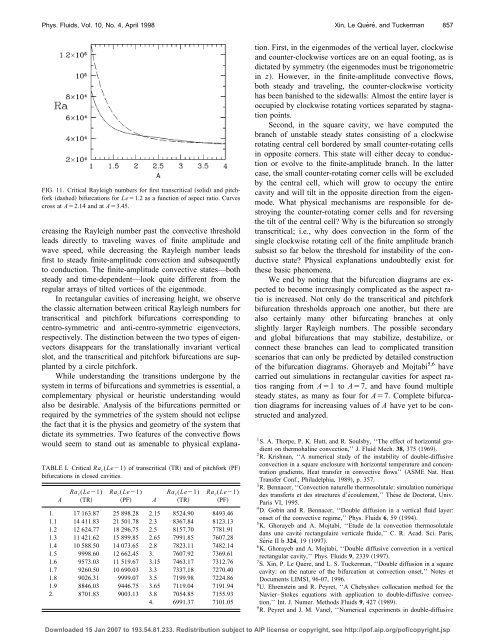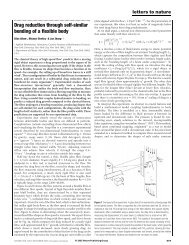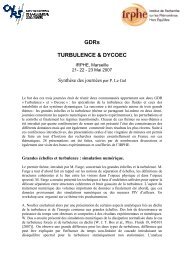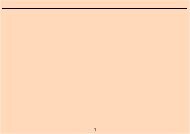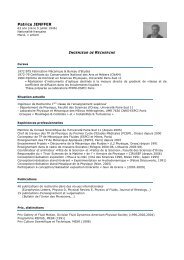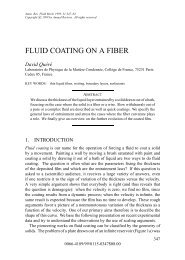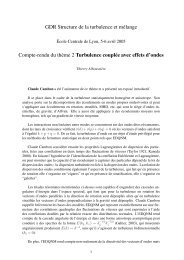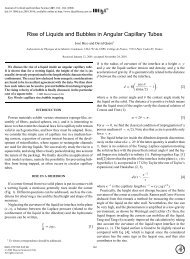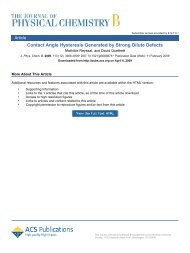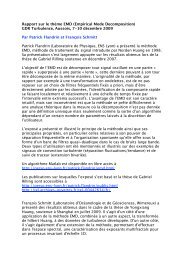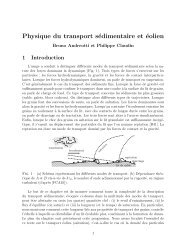Bifurcation analysis of double-diffusive convection with ... - Limsi
Bifurcation analysis of double-diffusive convection with ... - Limsi
Bifurcation analysis of double-diffusive convection with ... - Limsi
Create successful ePaper yourself
Turn your PDF publications into a flip-book with our unique Google optimized e-Paper software.
Phys. Fluids, Vol. 10, No. 4, April 1998Xin, Le Quéré, and Tuckerman857FIG. 11. Critical Rayleigh numbers for first transcritical solid and pitchforkdashed bifurcations for Le1.2 as a function <strong>of</strong> aspect ratio. Curvescross at A2.14 and at A3.45.TABLE I. Critical Ra c (Le1) <strong>of</strong> transcritical TR and <strong>of</strong> pitchfork PFbifurcations in closed cavities.ARa c (Le1)TRRa c (Le1)PFARa c (Le1)TRRa c (Le1)PF1. 17 163.87 25 898.28 2.15 8524.90 8493.461.1 14 411.83 21 501.78 2.3 8367.84 8123.131.2 12 624.77 18 296.75 2.5 8157.70 7781.911.3 11 421.62 15 899.85 2.65 7991.85 7607.281.4 10 588.50 14 073.65 2.8 7823.11 7482.141.5 9998.60 12 662.45 3. 7607.92 7369.611.6 9573.03 11 519.67 3.15 7463.17 7312.761.7 9260.50 10 690.03 3.3 7337.18 7270.401.8 9026.31 9999.07 3.5 7199.98 7224.861.9 8846.03 9446.75 3.65 7119.04 7191.942. 8701.83 9003.13 3.8 7054.85 7155.934. 6991.37 7101.05creasing the Rayleigh number past the convective thresholdleads directly to traveling waves <strong>of</strong> finite amplitude andwave speed, while decreasing the Rayleigh number leadsfirst to steady finite-amplitude <strong>convection</strong> and subsequentlyto conduction. The finite-amplitude convective states—bothsteady and time-dependent—look quite different from theregular arrays <strong>of</strong> tilted vortices <strong>of</strong> the eigenmode.In rectangular cavities <strong>of</strong> increasing height, we observethe classic alternation between critical Rayleigh numbers fortranscritical and pitchfork bifurcations corresponding tocentro-symmetric and anti-centro-symmetric eigenvectors,respectively. The distinction between the two types <strong>of</strong> eigenvectorsdisappears for the translationally invariant verticalslot, and the transcritical and pitchfork bifurcations are supplantedby a circle pitchfork.While understanding the transitions undergone by thesystem in terms <strong>of</strong> bifurcations and symmetries is essential, acomplementary physical or heuristic understanding wouldalso be desirable. Analysis <strong>of</strong> the bifurcations permitted orrequired by the symmetries <strong>of</strong> the system should not eclipsethe fact that it is the physics and geometry <strong>of</strong> the system thatdictate its symmetries. Two features <strong>of</strong> the convective flowswould seem to stand out as amenable to physical explanation.First, in the eigenmodes <strong>of</strong> the vertical layer, clockwiseand counter-clockwise vortices are on an equal footing, as isdictated by symmetry the eigenmodes must be trigonometricin z. However, in the finite-amplitude convective flows,both steady and traveling, the counter-clockwise vorticityhas been banished to the sidewalls: Almost the entire layer isoccupied by clockwise rotating vortices separated by stagnationpoints.Second, in the square cavity, we have computed thebranch <strong>of</strong> unstable steady states consisting <strong>of</strong> a clockwiserotating central cell bordered by small counter-rotating cellsin opposite corners. This state will either decay to conductionor evolve to the finite-amplitude branch. In the lattercase, the small counter-rotating corner cells will be excludedby the central cell, which will grow to occupy the entirecavity and will tilt in the opposite direction from the eigenmode.What physical mechanisms are responsible for destroyingthe counter-rotating corner cells and for reversingthe tilt <strong>of</strong> the central cell? Why is the bifurcation so stronglytranscritical; i.e., why does <strong>convection</strong> in the form <strong>of</strong> thesingle clockwise rotating cell <strong>of</strong> the finite amplitude branchsubsist so far below the threshold for instability <strong>of</strong> the conductivestate? Physical explanations undoubtedly exist forthese basic phenomena.We end by noting that the bifurcation diagrams are expectedto become increasingly complicated as the aspect ratiois increased. Not only do the transcritical and pitchforkbifurcation thresholds approach one another, but there arealso certainly many other bifurcating branches at onlyslightly larger Rayleigh numbers. The possible secondaryand global bifurcations that may stabilize, destabilize, orconnect these branches can lead to complicated transitionscenarios that can only be predicted by detailed construction<strong>of</strong> the bifurcation diagrams. Ghorayeb and Mojtabi 5,6 havecarried out simulations in rectangular cavities for aspect ratiosranging from A1 to A7, and have found multiplesteady states, as many as four for A7. Complete bifurcationdiagrams for increasing values <strong>of</strong> A have yet to be constructedand analyzed.1 S. A. Thorpe, P. K. Hutt, and R. Soulsby, ‘‘The effect <strong>of</strong> horizontal gradienton thermohaline <strong>convection</strong>,’’ J. Fluid Mech. 38, 375 1969.2 R. Krishnan, ‘‘A numerical study <strong>of</strong> the instability <strong>of</strong> <strong>double</strong>-<strong>diffusive</strong><strong>convection</strong> in a square enclosure <strong>with</strong> horizontal temperature and concentrationgradients, Heat transfer in convective flows’’ ASME Nat. HeatTransfer Conf., Philadelphia, 1989, p. 357.3 R. Bennacer, ‘‘Convection naturelle thermosolutale: simulation numériquedes transferts et des structures d’écoulement,’’ Thèse de Doctorat, Univ.Paris VI, 1995.4 D. Gobin and R. Bennacer, ‘‘Double diffusion in a vertical fluid layer:onset <strong>of</strong> the convective regime,’’ Phys. Fluids 6, 591994.5 K. Ghorayeb and A. Mojtabi, ‘‘Étude de la <strong>convection</strong> thermosolutaledans une cavité rectangulaire verticale fluide,’’ C. R. Acad. Sci. Paris,Série II b 324, 191997.6 K. Ghorayeb and A. Mojtabi, ‘‘Double <strong>diffusive</strong> <strong>convection</strong> in a verticalrectangular cavity,’’ Phys. Fluids 9, 2339 1997.7 S. Xin, P. Le Quéré, and L. S. Tuckerman, ‘‘Double diffusion in a squarecavity: on the nature <strong>of</strong> the bifurcation at <strong>convection</strong> onset,’’ Notes etDocuments LIMSI, 96-07, 1996.8 U. Ehrenstein and R. Peyret, ‘‘A Chebyshev collocation method for theNavier–Stokes equations <strong>with</strong> application to <strong>double</strong>-<strong>diffusive</strong> <strong>convection</strong>,’’Int. J. Numer. Methods Fluids 9, 427 1989.9 R. Peyret and J. M. Vanel, ‘‘Numerical experiments in <strong>double</strong>-<strong>diffusive</strong>Downloaded 15 Jan 2007 to 193.54.81.233. Redistribution subject to AIP license or copyright, see http://p<strong>of</strong>.aip.org/p<strong>of</strong>/copyright.jsp


